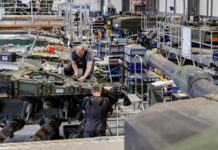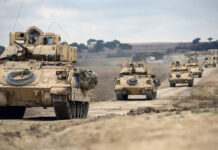Three of the world’s leading aerospace companies released today their first quarterly reports for 2011. All three reported healthy margins despite the challenging business environment and uncertainty reflected in the global defense sector. While all reports present stable forecast and reiterate previous financial outlooks, they also highlight the intensive activities companies are undertaking to ensure financial stability to support them through difficult times ahead.
![]() Boeing reported today revenue of $14.9 billion, adding $23 billion in new orders, bringing its total backlog to $329 billion. About half of the total revenues were reported by Boeing Defense Systems (BDS) – $7.617 billion, slightly higher than Q1 2010. Boeing’s Military aircraft business grew five percent during the quarter, reflecting a better mix of global strike programs and lower spending on research and development. Backlog at BDS increased slightly to $66 billion, approximately two times the unit’s expected 2011 revenue. The company’s Networks and space business maintained one percent growth, while Global Service & Support (GS&S) operations declined eight percent.
Boeing reported today revenue of $14.9 billion, adding $23 billion in new orders, bringing its total backlog to $329 billion. About half of the total revenues were reported by Boeing Defense Systems (BDS) – $7.617 billion, slightly higher than Q1 2010. Boeing’s Military aircraft business grew five percent during the quarter, reflecting a better mix of global strike programs and lower spending on research and development. Backlog at BDS increased slightly to $66 billion, approximately two times the unit’s expected 2011 revenue. The company’s Networks and space business maintained one percent growth, while Global Service & Support (GS&S) operations declined eight percent.
Maintaining this growth at times of financial uncertainty had its cost. While Boeing’s military aircraft division presented a sharp improvement of 37 percent, over the first quarter of 2010, reported earnings from operations for both Networks and Space and Global Services & Support declined in the recent quarter by 18% and 28% respectively. These operations were affected by lower earnings in the satellite business and the conclusion of the U.S. Air Force KC-10 support program. However, during the quarter, GS&S won Performance Based Logistics (PBL) contract for the C-17 Globemaster III Sustainment Partnership, paving the way for sustainable performance in the future. Boeing also won a follow-on order extending F-22 sustainment contracts.
![]() Lockheed Martin reported yesterday net sales of $10.6 billion for the period, with earnings from continuing operations of $548 million. Sales of the aeronautics segment increased to $3.182 billion, up from$ 2.940 in the first quarter last year. Electronics Systems also increased to $3.459 billion (six percent up from $3.250 billion) while information systems and space systems both decreased to $2.149 and $1.843 billion respectively. However, all divisions except Information Systems (IS) presented higher profitability.
Lockheed Martin reported yesterday net sales of $10.6 billion for the period, with earnings from continuing operations of $548 million. Sales of the aeronautics segment increased to $3.182 billion, up from$ 2.940 in the first quarter last year. Electronics Systems also increased to $3.459 billion (six percent up from $3.250 billion) while information systems and space systems both decreased to $2.149 and $1.843 billion respectively. However, all divisions except Information Systems (IS) presented higher profitability.
The Aeronautics division presented a healthy eight percent increase, adding $235 million in C-130J business, due to an increase in deliveries (Six C-130J were delivered in the first quarter of 2011, compared only to three in Q1 last year). Growing support activities also contributed to the growth, while increasing production volumes of the F-35, currently produced at ‘low-rate initial production’ (LRIP) contributed additional $220 million. On the down side, the company is winding down its F-22 operations with final deliveries expected next year. Despite the growth in activity, Aerospace business profitability remained almost unchanged – as new production (LRIP) contracts associated with the F-35 are typically yielding lower profits than mature production programs. Lockheed Martin’s Electronics Systems also represented a healthy growth this quarter, reflecting gains of about $130 million from radar programs associated with air-defense systems such as Patriot Advanced Capability-3 (PAC-3).
![]() Northrop Grumman’s Q1/2011 report reflected the challenging transformation the company has gone through in recent months, divesting its shipbuilding business and reducing its participation in the Nevada National Security Site (NSTec) a Joint Venture with the U.S. Government tasked with storage management and experimentation with nuclear materials.
Northrop Grumman’s Q1/2011 report reflected the challenging transformation the company has gone through in recent months, divesting its shipbuilding business and reducing its participation in the Nevada National Security Site (NSTec) a Joint Venture with the U.S. Government tasked with storage management and experimentation with nuclear materials.
Northrop Grumman reported first quarter 2011 sales totaling $6.7 billion, about $200 million off the $6.9 billion reported in the first quarter of 2010, excluding the revenues derived by the shipbuilding division. Despite the reduction in sales, operating income increased 19 percent to $811 million (up from $679 million last year).
The company’s Aerospace division was the only unit reporting growth in this quarter, with sales of $ 2.736 billion, representing a 1.5 percent growth, due to higher volume for manned and unmanned aircraft and restricted programs. The Electronics Systems division dropped four percent to $ 1.808 billion, by slower activity in land and self-protection systems, although targeting systems maintained a healthy level at the reported period. Intelligence Programs division has also declined two percent, with one of its classified programs transitioning from development to maintenance. Nevertheless, all divisions reported improved operating margins, contributing to better profitability.
“This was a very productive quarter. We completed the shipbuilding spin-off and our newly aligned portfolio generated solid financial results. We now expect 2011 earnings of $6.50 to $6.70 per share. We also increased the dividend and raised our outstanding share repurchase authorization to $4 billion, which includes committing the $1.4 billion contribution we received in the shipbuilding spin-off to share repurchases,” said Wes Bush, chief executive officer and president. “In today’s challenging environment, our actions demonstrate our continued commitment to value creation through performance improvement, portfolio management and effective cash deployment,” Bush added.

















